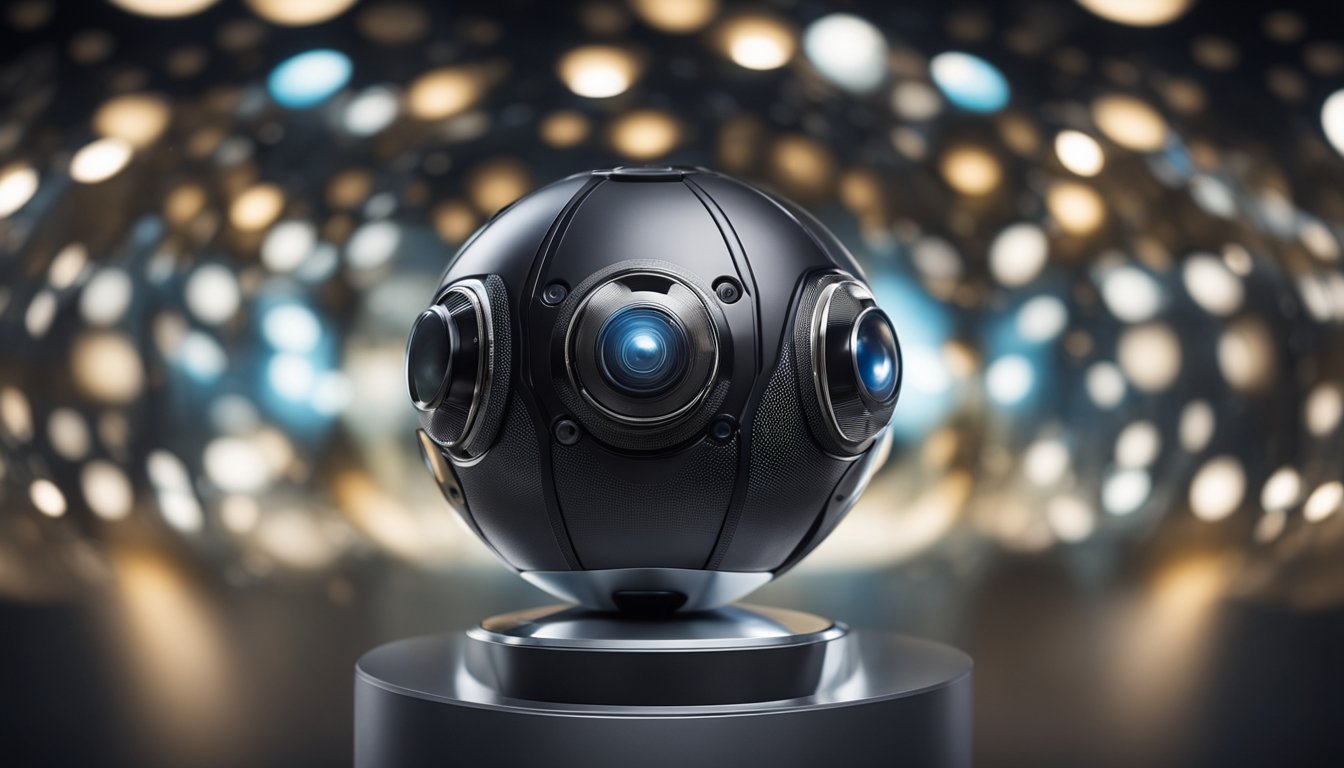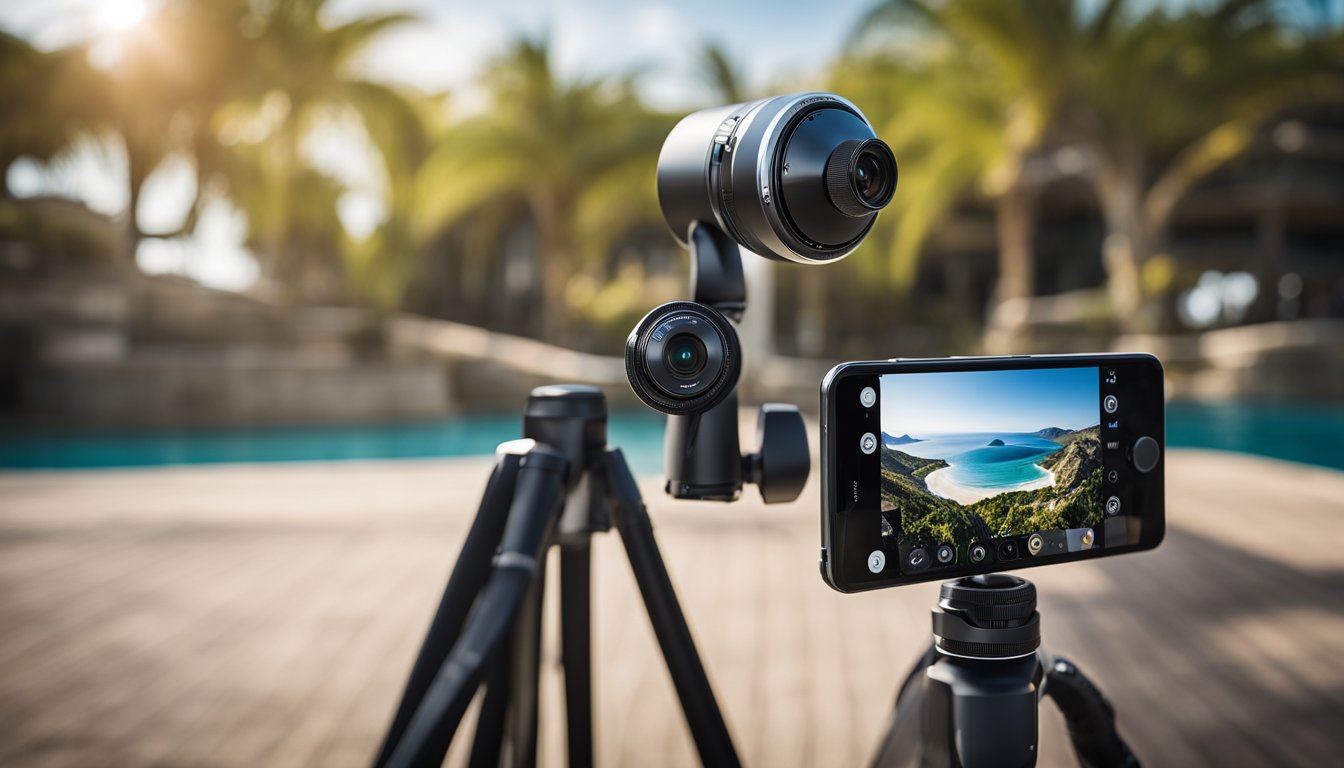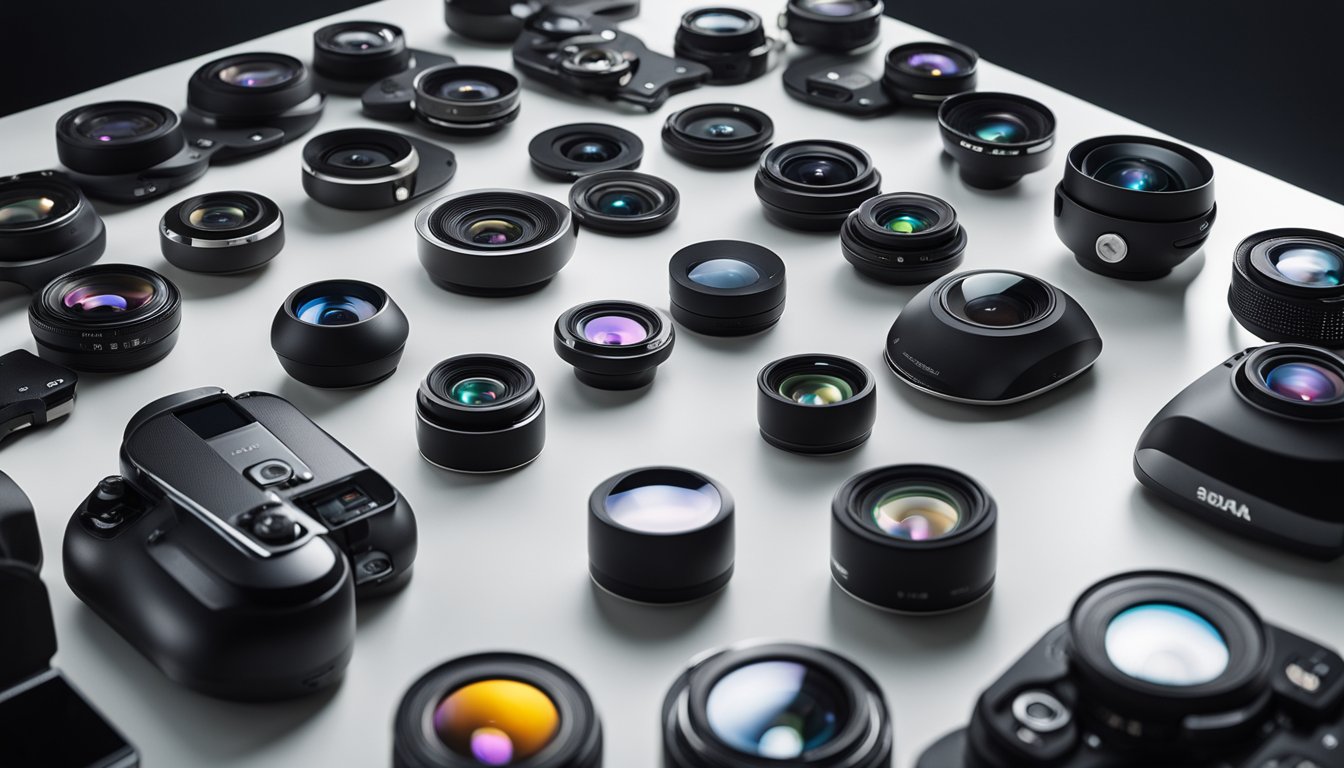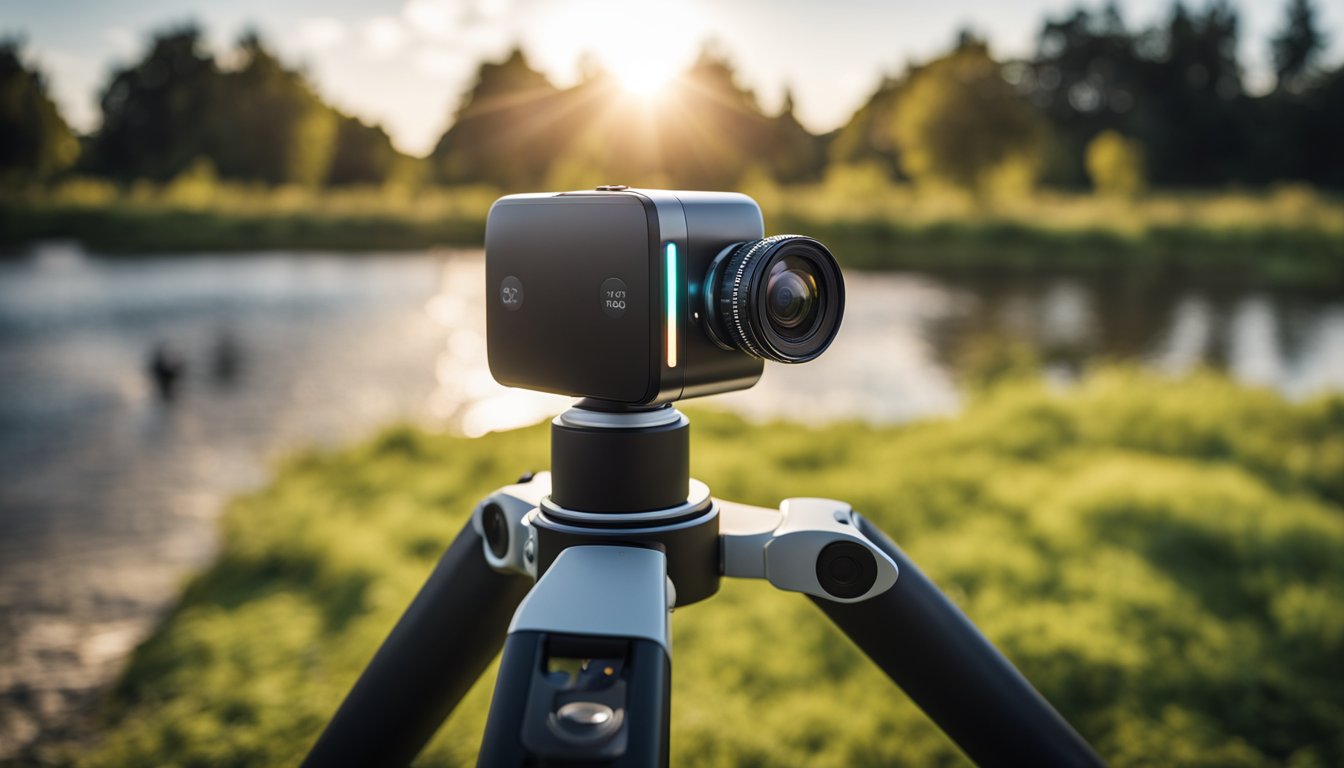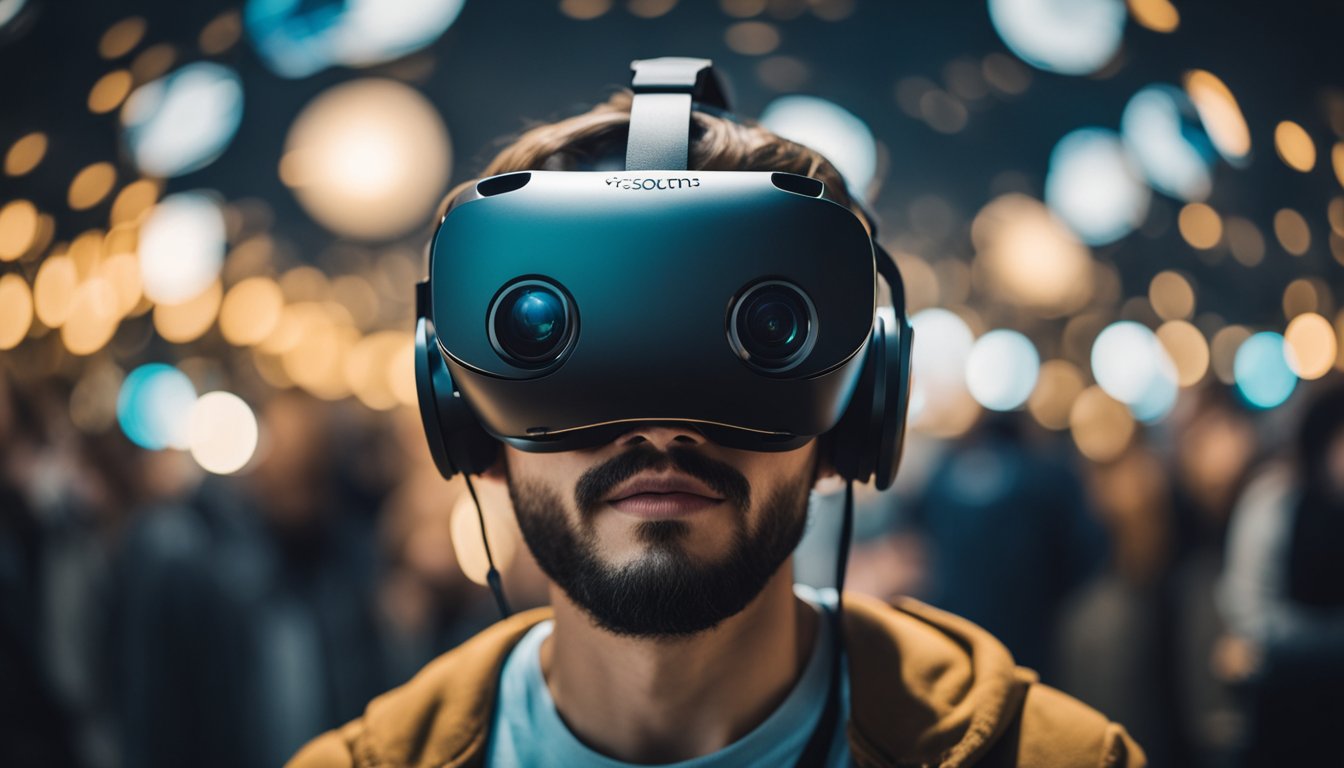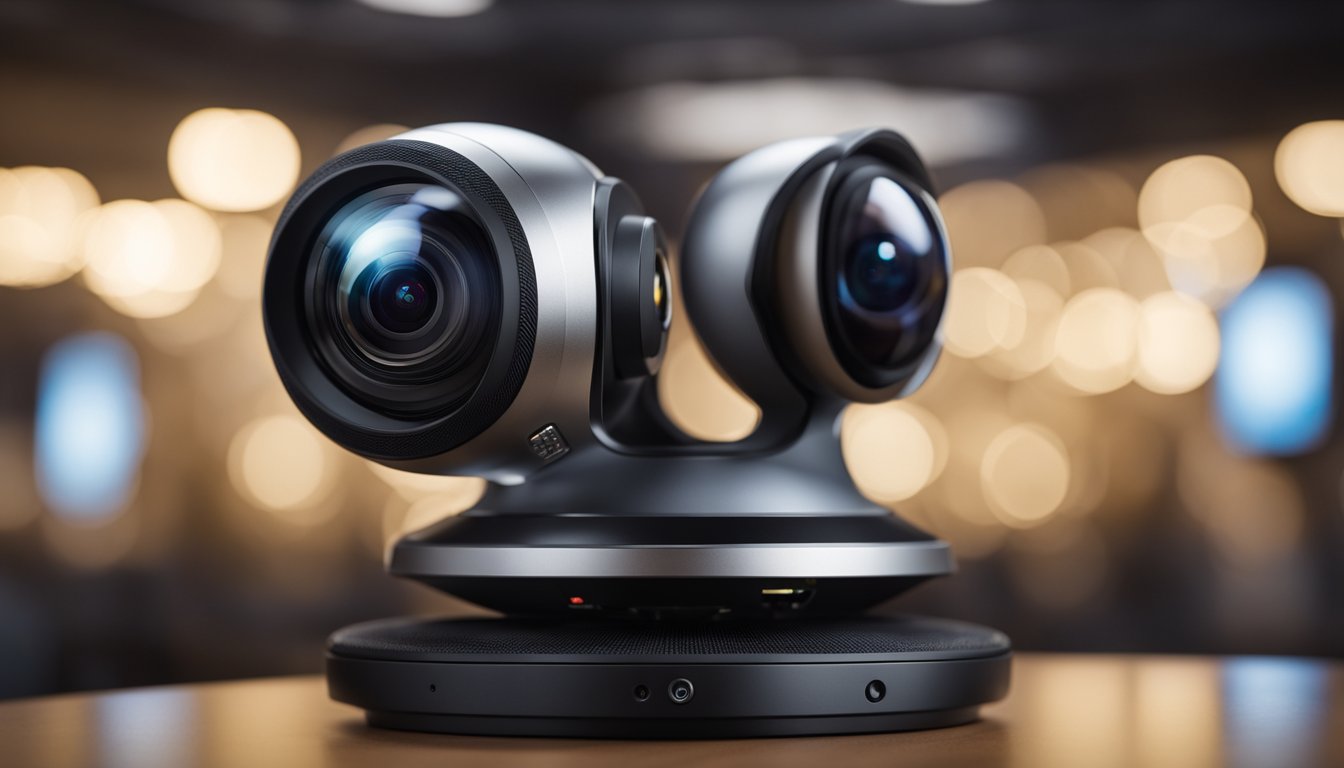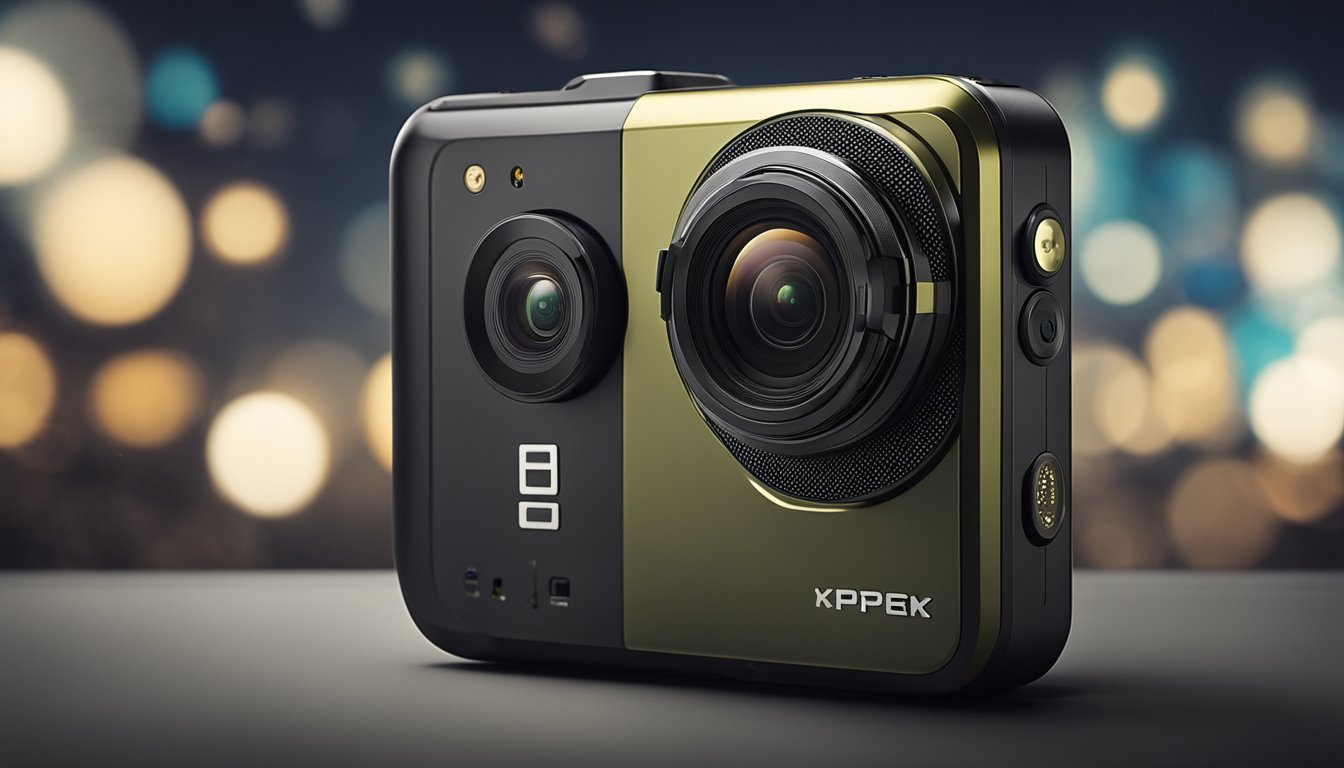If you’re interested in capturing immersive 360-degree photos and videos, you may be wondering what a 360 camera looks like. Unlike traditional cameras, 360 cameras are designed to capture a full 360-degree view of the world around you, allowing you to explore and interact with your photos and videos in new and exciting ways.
A 360 camera typically looks like a small, compact device with multiple lenses or a single lens that can capture a full 360-degree view of the world around you. Depending on the model, a 360 camera may also feature a built-in display screen, buttons for controlling the camera’s settings, and a variety of other advanced features for enthusiasts. Some popular 360 camera models include the GoPro MAX, Insta360 ONE R, and Ricoh Theta Z1.
Key Takeaways

- A 360 camera is designed to capture a full 360-degree view of the world around you.
- Most 360 cameras are small, compact devices with multiple lenses or a single lens.
- Popular 360 camera models include the GoPro MAX, Insta360 ONE R, and Ricoh Theta Z1.
Understanding 360 Cameras
If you are new to 360 cameras, you might be wondering what they look like and how they work. In this section, we will take a closer look at the design, lenses, sensors, resolution, and image quality of 360 cameras.
Design and Build
360 cameras come in various shapes and sizes, but most of them have a spherical or cylindrical shape. They are designed to capture 360-degree footage, which means they need to have lenses on both sides of the camera. Some 360 cameras have a single lens that rotates to capture the entire scene, while others have two or more lenses that capture everything simultaneously.
Lenses and Sensors
The lenses and sensors of a 360 camera are crucial to the quality of the footage. Most 360 cameras use back-to-back fisheye lenses to capture a full 360-degree view. Fisheye lenses have a wide-angle view that allows them to capture more of the scene than traditional lenses. The sensors of a 360 camera are also important, as they determine the resolution and image quality of the footage.
Resolution and Image Quality
The resolution and image quality of 360 cameras vary depending on the model and brand. Some 360 cameras have a resolution of 4K or higher, while others have a lower resolution. The image quality of a 360 camera is determined by factors such as the lenses, sensors, and image processing software. Higher-end 360 cameras generally produce better image quality than lower-end models.
« What is the Best 360 Camera for Capturing Stunning VR Footage?
Which 360 Camera is Best: A Comprehensive Guide to Choosing the Right One for You »
In conclusion, 360 cameras are designed to capture 360-degree footage using back-to-back fisheye lenses and sensors. The quality of the footage depends on factors such as the resolution, image quality, and image processing software.
Popular 360 Camera Models
If you’re looking for a 360 camera, you have plenty of options to choose from. Here are some popular 360 camera models that are worth checking out:
Consumer Favorites
GoPro Max
The GoPro Max is a popular choice for consumers who want a 360 camera that’s easy to use and delivers high-quality footage. It’s waterproof, has a touch screen, and can shoot 360 video in 5.6K resolution. It also has a feature called “Max HyperSmooth” that provides smooth video stabilization.
Insta360 One R
The Insta360 One R is another popular choice for consumers. It’s a modular camera that allows you to switch out lenses and sensors, so you can customize it to your needs. It can shoot 360 video in 5.7K resolution, and it has a touch screen and voice control.
Ricoh Theta SC2
The Ricoh Theta SC2 is a compact and easy-to-use 360 camera that’s great for beginners. It can shoot 360 video in 4K resolution, and it has a built-in 360-degree microphone. It also has a slim and lightweight design that makes it easy to carry around.
Professional Picks
Insta360 X3
The Insta360 X3 is a popular choice for professional photographers and videographers. It can shoot 360 video in 8K resolution, and it has a compact and lightweight design that makes it easy to carry around. It also has advanced features like “FlowState Stabilization” and “HDR Video.”
GoPro Fusion
The GoPro Fusion is another popular choice for professionals. It can shoot 360 video in 5.2K resolution, and it has features like “OverCapture” that allow you to reframe your footage in post-production. It’s also waterproof, has a touch screen, and can shoot time-lapse videos.
Kandao QooCam
The Kandao QooCam is a versatile 360 camera that’s great for professionals who need a camera that can do it all. It can shoot 360 video in 8K resolution, and it has a built-in screen and a variety of shooting modes. It also has advanced features like “SuperSteady” stabilization and “HDR Photo.”
Samsung Gear 360
The Samsung Gear 360 is a popular choice for professionals who need a 360 camera that’s easy to use and delivers high-quality footage. It can shoot 360 video in 4K resolution, and it has a slim and lightweight design that makes it easy to carry around. It also has features like “Live Broadcast” that allow you to stream your footage in real-time.
Overall, there are many great options when it comes to 360 cameras. Whether you’re a consumer or a professional, there’s a camera out there that will meet your needs.
Capturing 360 Videos and Photos
https://www.youtube.com/watch?v=RHejHmUZR_U&embed=true
Capturing 360 videos and photos is an exciting way to document your adventures and experiences. With a 360 camera, you can capture everything around you in a single shot. Here are some tips to help you get the most out of your 360 camera.
Framing Techniques
When capturing 360 videos and photos, framing is important to ensure that your subject is in the frame and that the action shots are captured correctly. One technique is to use the “me mode” where the camera is pointed towards you, and you can capture your surroundings. Another technique is to use the “follow mode” where the camera follows the subject and captures their movements. You can also use the “static mode” where the camera is stationary and captures everything around it.
Shooting Modes
360 cameras have various shooting modes that you can use to capture different types of footage. Some cameras have a video mode that allows you to capture 360-degree videos, while others have a photo mode that allows you to capture 360-degree photos. Some cameras also have a timelapse mode that allows you to capture a series of photos over a period of time.
When capturing 360 videos and photos, it’s important to experiment with different shooting modes to see which one works best for your needs. For example, if you’re capturing action shots, you may want to use the video mode, while if you’re capturing landscapes, you may want to use the photo mode.
In conclusion, capturing 360 videos and photos is an exciting way to document your adventures and experiences. By experimenting with different framing techniques and shooting modes, you can capture stunning footage that will transport you back to that moment in time.
The Editing Workflow
Once you have captured your 360-degree footage, you will need to edit it to create a polished final product. Editing a 360 video is different from traditional video editing since you are working with a spherical image. In this section, we will look at the editing workflow for 360 videos.
Stitching and Reframing
The first step in the editing process is to stitch the footage together. This process involves taking the footage from each lens and combining it into a single 360-degree video. There are several software options available for stitching 360-degree footage, including Adobe Premiere Pro, Final Cut Pro, and Insta360 Studio.
Once your footage is stitched together, you can begin the reframing process. Reframing allows you to change the perspective of the video by adjusting the field of view. This process is similar to cropping a traditional video, but instead of cropping a rectangular frame, you are cropping a spherical frame.
Editing Tools and Software
After stitching and reframing your footage, you can begin the actual editing process. Many of the tools and techniques used in traditional video editing can be applied to 360 videos, including adding transitions, music, and text overlays. However, there are also some specific tools and software designed for 360 video editing.
One popular 360 video editing tool is the GoPro VR Player. This software allows you to preview your footage in a 360-degree environment, making it easier to see how your edits will affect the final product. Another popular option is the Insta360 Studio software, which includes a range of editing tools specifically designed for 360-degree footage.
In conclusion, editing a 360-degree video requires a different workflow than traditional video editing. You will need to stitch your footage together, reframe it, and then use specific tools and software to edit the final product. With the right tools and techniques, you can create a stunning 360-degree video that will captivate your audience.
Enhancing Video Quality
https://www.youtube.com/watch?v=ZrlssbgbdhQ&embed=true
When it comes to 360 cameras, video quality is one of the most important factors to consider. However, even the best 360 cameras may produce videos that are not up to par. Fortunately, there are several features that can enhance video quality and make your footage look more professional.
Stabilization Features
One of the most common issues with 360 videos is shakiness, which can be caused by camera movement or user movement. To combat this problem, many 360 cameras offer stabilization features that can smooth out your footage. Some cameras even have built-in gyroscopes that can detect movement and adjust the footage accordingly.
HDR and Exposure Settings
HDR (High Dynamic Range) and exposure settings are also important for enhancing video quality. HDR mode can capture more detail in both bright and dark areas of your footage, resulting in a more balanced image. Exposure settings can help you adjust the brightness of your footage, which is especially important when shooting in low-light conditions.
When using HDR and exposure settings, it’s important to find the right balance. Overexposure can result in washed-out footage, while underexposure can make your footage too dark. Many 360 cameras offer an active HDR mode that can automatically adjust these settings for you.
In conclusion, enhancing video quality is an important consideration when choosing a 360 camera. Stabilization features and HDR and exposure settings can help you produce professional-looking footage that is smooth and well-balanced.
Diving into Virtual Reality
If you’re looking to capture immersive 360-degree images and videos, you need a 360 camera. With a 360 camera, you can transport people to another dimension and create mind-blowing virtual reality experiences.
VR Integration
With the rise of virtual reality (VR) technology, 360 cameras have become increasingly popular. Many VR headsets now support 360-degree video playback, allowing you to experience immersive viewing experiences. Some popular VR headsets include the Oculus Rift, HTC Vive, and Samsung Gear VR.
When you shoot 360-degree footage, the images are stitched together to create a seamless, immersive experience. The resulting video can be viewed on a VR headset, allowing the viewer to look around and explore the environment.
Immersive Viewing Experiences
360 cameras allow you to capture images and videos that are more immersive than traditional cameras. With a 360 camera, you can capture every angle, every detail, and create immersive viewing experiences.
When you view a 360-degree video, you have the ability to look around and explore the environment. This gives you a sense of presence and immersion that traditional videos can’t match.
Whether you’re a professional photographer or just looking to capture your vacation memories, a 360 camera can help you create immersive, unforgettable experiences. With the ability to capture 360-degree images and videos, you can transport people to another dimension and create mind-blowing virtual reality experiences.
Sharing and Livestreaming
https://www.youtube.com/watch?v=mn4A9cjh7RI&embed=true
If you’re looking to share your 360 camera content with others, there are plenty of options available to you. Social media platforms like YouTube, Instagram, and Facebook all support 360-degree videos and photos, so you can easily upload your content and share it with your friends and followers.
Social Media Platforms
YouTube is one of the most popular platforms for sharing 360-degree videos. To upload a 360 video to YouTube, you simply need to select the 360 Video checkbox in the upload process. Once uploaded, viewers can watch the video in 360 degrees by moving their phone or dragging their mouse around the video.
Instagram also supports 360-degree photos and videos, but you’ll need to use a third-party app to upload them. One popular app for uploading 360 content to Instagram is called “Panorama 360 Camera“. This app allows you to take 360-degree photos and videos and then upload them to Instagram as a regular post.
Facebook is another popular platform for sharing 360-degree content. To upload a 360 video to Facebook, you’ll need to use a special metadata tool that’s provided by Facebook. This tool adds the necessary metadata to your video so that Facebook knows it’s a 360 video.
Real-time Broadcasting
If you’re interested in live-streaming your 360 content, there are also plenty of options available to you. Many social media platforms like Facebook and YouTube support live-streaming, so you can easily broadcast your 360 content in real-time.
To live-stream with a 360 camera, you’ll need to make sure that your camera supports live-streaming and that you have a stable internet connection. Some popular 360 cameras that support live-streaming include the Insta360 Pro 2 and the GoPro Fusion.
Overall, sharing and live-streaming your 360 content is easier than ever thanks to the wide range of platforms and tools available to you. Whether you’re looking to share your content with friends and family on social media or broadcast it to a wider audience, there are plenty of options available to you.
Storage and Connectivity
When it comes to storage, most 360 cameras come with built-in memory that can hold a limited amount of footage. However, you can expand the memory options by using an SD card or microSD card. These cards are small and can store a large amount of data, making them ideal for capturing 360 footage. You can easily insert a memory card into your 360 camera and start recording without worrying about running out of space.
Memory Options
If you plan on capturing a lot of footage, it’s best to get a 360 camera that supports larger memory cards. Some cameras can support up to 256GB microSD cards, which can store hours of footage. Keep in mind that the higher the resolution and frame rate, the more storage space you’ll need. So, if you plan on shooting in 4K or 8K, you’ll need a lot of storage space.
Wireless Transfers
Most 360 cameras come with Wi-Fi connectivity, which allows you to transfer footage wirelessly to your smartphone or computer. This is a convenient feature that saves you time and hassle. You can easily connect your camera to your phone or computer and transfer footage without having to use any cables.
Some cameras also come with Bluetooth connectivity, which allows you to control your camera remotely using your smartphone. This is useful if you want to capture footage from a distance or if you want to set up your camera in a hard-to-reach location.
In conclusion, storage and connectivity are important factors to consider when buying a 360 camera. Make sure to choose a camera that supports larger memory cards if you plan on capturing a lot of footage, and look for cameras with Wi-Fi and Bluetooth connectivity for easy transfers and remote control.
Durability and Portability
When choosing a 360 camera, it is important to consider its durability and portability. You want a camera that can withstand some rough handling and is easy to carry around with you.
Waterproof and Rugged Design
If you plan on using your 360 camera outdoors or in wet conditions, then you will want to look for a camera with a waterproof or water-resistant design. This will allow you to take your camera with you on adventures like kayaking, snorkeling, or even scuba diving. Some cameras are even designed to be shockproof and dustproof, making them ideal for use in rugged environments.
Travel-friendly Features
If you plan on taking your 360 camera with you on your travels, then you will want to look for a camera that is slim and portable. Some cameras are designed to be small and lightweight, making them easy to carry around in your pocket or backpack. Additionally, some cameras come with travel-friendly features like built-in Wi-Fi, allowing you to easily transfer your photos and videos to your smartphone or tablet while on the go.
Overall, when choosing a 360 camera, you want to look for a camera with a durable build quality and slim, portable design that can withstand some rough handling and is easy to carry around with you.
Advanced Features for Enthusiasts
https://www.youtube.com/watch?v=bf_DxNsha38&embed=true
If you are an advanced or professional user, you will appreciate the manual controls and settings that come with a 360 camera. These features give you more control over your shots and allow you to achieve the exact look and feel you want.
Manual Controls and Settings
With a 360 camera, you can adjust the shutter speed, aperture, and ISO settings to achieve the perfect exposure. This is especially useful in low light situations where you need to adjust the settings to capture the best shot. Additionally, many 360 cameras come with a manual focus feature that allows you to focus on a specific subject or area in the frame.
Some 360 cameras also have a viewfinder or LCD screen that lets you preview your shot before you take it. This is particularly helpful when you need to ensure that the shot is perfectly aligned or framed.
Accessory Ecosystem
For vlogging or professional use, 360 cameras have a range of accessories that can enhance your shooting experience. Some popular accessories include tripods, mounts, and gimbals. These accessories help stabilize your camera and allow you to capture smooth, steady shots.
Moreover, some 360 cameras have a zoom feature that allows you to zoom in and out of your shot. This is particularly useful when you want to focus on a specific subject or area in the frame.
In conclusion, if you are an advanced or professional user, you will appreciate the manual controls and settings, as well as the range of accessories available for 360 cameras. These features allow you to achieve the exact look and feel you want, and enhance your shooting experience.
Choosing the Right 360 Camera
https://www.youtube.com/watch?v=5MvtlBYOFHg&embed=true
When it comes to choosing the right 360 camera, there are several factors to consider. Whether you’re a beginner or a professional, there’s a 360 camera that’s perfect for your needs. In this section, we’ll discuss the different types of 360 cameras available and which one is right for you.
For Beginners and Amateurs
If you’re new to 360 cameras, it’s best to start with a basic model that’s easy to use. Action cameras like the Insta360 One R or the GoPro MAX are great for beginners and amateurs. They’re small, lightweight, and easy to carry around. They’re also rugged and can handle rough outdoor conditions.
For those who want something a little more advanced, the Insta360 One is a great option. It’s a popular choice among vloggers and virtual tour creators. It’s easy to use, has great image quality, and is affordable.
For Professionals and Content Creators
If you’re a professional or a content creator, you’ll want a 360 camera that can handle more advanced features. The Insta360 One R and the Insta360 One RS are both great options. They’re both modular cameras that allow you to swap out lenses and sensors. This gives you more flexibility and control over your shots.
For those who want the best image quality possible, a DSLR with a 360 lens attachment is the way to go. This is a more expensive option, but it gives you the most control over your shots. It’s also great for creating street view images and virtual tours.
No matter what your skill level or budget, there’s a 360 camera that’s perfect for you. Consider your needs and choose a camera that fits your style and budget.
Frequently Asked Questions
https://www.youtube.com/watch?v=5xds4olIjw0&embed=true
How can I tell if a camera is capable of 360-degree recording?
To determine if a camera is capable of 360-degree recording, look for cameras with dual lenses. These cameras are designed to capture images and videos from all angles. Additionally, 360 cameras often have a panoramic viewfinder that allows you to see the entire scene you are recording.
What are the visual differences between 360 footage and regular video?
360 footage captures the entire scene in a spherical view, while regular video captures only what is in front of the camera. 360 footage also allows the viewer to interact with the video, changing the point of view and exploring the scene from different angles.
What sets a 360 camera apart from a traditional camera?
360 cameras are designed to capture everything around you, while traditional cameras capture only what is in front of the lens. 360 cameras also allow for immersive experiences, giving the viewer the ability to explore the scene from any angle.
What should I look for in a 360 camera for creating YouTube content?
When looking for a 360 camera for creating YouTube content, consider the camera’s resolution, image stabilization, and compatibility with YouTube’s 360 video format. Additionally, look for cameras with built-in editing features to make the editing process easier.
Are there affordable options for 360 cameras on the market?
Yes, there are affordable options for 360 cameras on the market. Some popular options include the Insta360 One X2 and the Ricoh Theta SC2.
How do 360 cameras work to capture every angle?
360 cameras use multiple lenses to capture a full spherical view of the surroundings, creating immersive images and videos that put you at the center of the scene. The camera captures everything around you simultaneously, allowing for a complete view in every direction.

